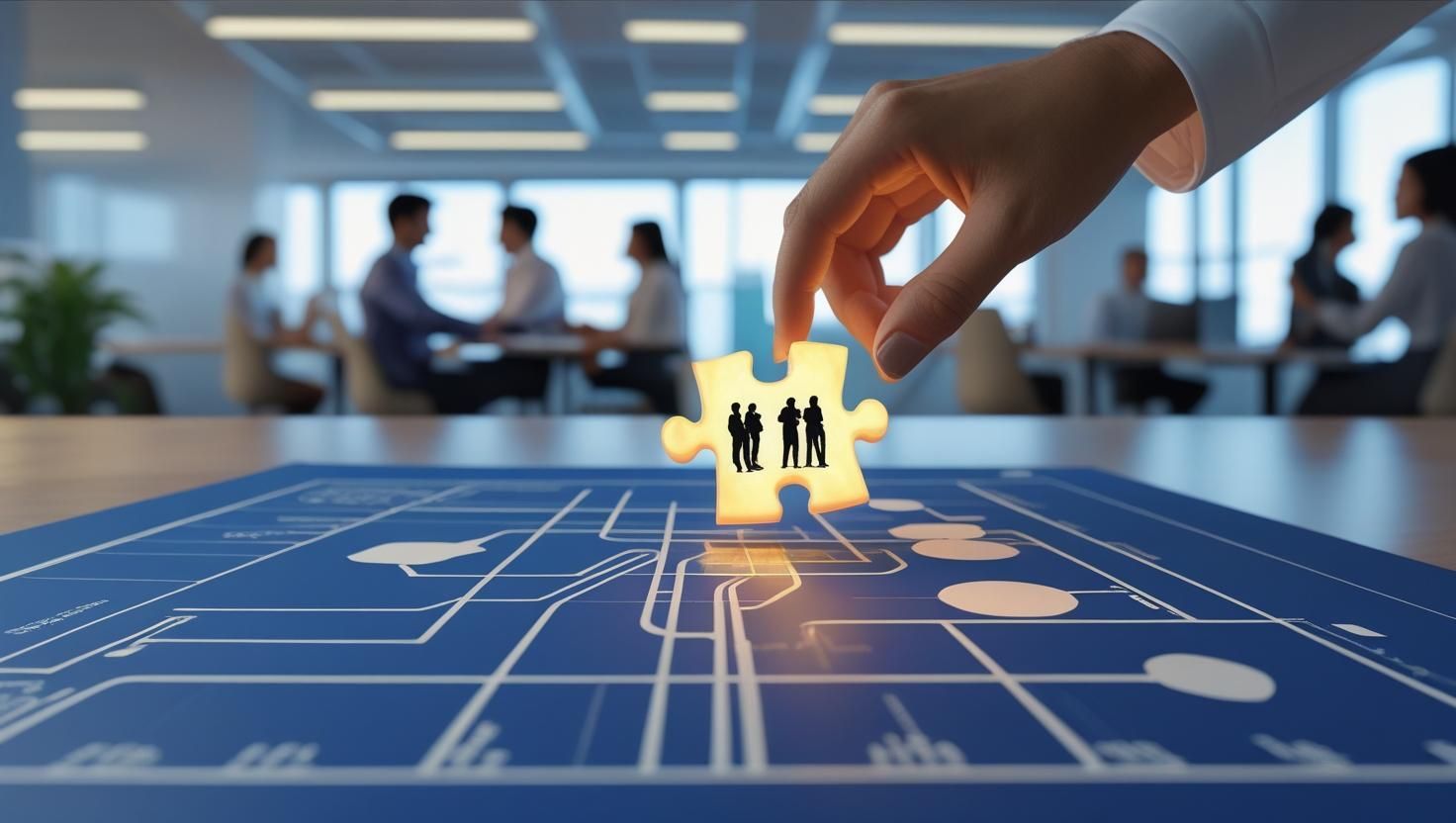Beyond the Boardroom: Real SMB Stories & Your Unseen Power in M&A
Executive Summary
We've explored the silent costs of M&A—the cultural clashes and the heartbreaking exodus of talent. Now, let’s get real. This article brings the conversation home with relatable stories from other small and medium-sized businesses, showcasing where things went sideways and, more importantly, where prioritizing people led to incredible success.
You’ll also discover your own unique and indispensable role as the selling founder during this transition. You’re not just a signatory on a deal; you're the crucial bridge and champion, whose presence and commitment are vital to securing your legacy, safeguarding your loyal team, and ensuring your financial earn-out.
In our previous articles, we’ve faced some tough realities, haven't we? We've explored the profound impact of cultural clashes on your company’s identity and the quiet heartbreak of seeing loyal employees and invaluable "know-how" walk out the door. You’ve felt that imagined knife to your heart, seeing Susan strained and hearing Tom’s bitter disappointment. It's easy to feel overwhelmed when contemplating such a significant life event for yourself and your business.
But here’s where the story flips. These challenges are not insurmountable! While the initial allure of mergers and acquisitions is often rooted in financial synergies and market expansion, the overwhelming evidence demonstrates that their ultimate success is profoundly dependent on how effectively the human element is managed and integrated. The high failure rates of M&A deals, largely attributed to cultural clashes and people-related challenges, underscore that the "soft" aspects of human capital are, in fact, the "hard" determinants of long-term value creation.
This means that investing in cultural due diligence, transparent communication, and robust talent and knowledge retention isn't merely a risk-mitigation strategy or a "nice-to-have" HR function; it's a direct, quantifiable driver of value creation and a competitive advantage. It's about taking proactive steps to ensure your company—your life's work—continues to shine brightly in its next chapter.
I. Lessons from the Trenches: SMB Stories of Success and Struggle
You've seen the big corporate examples, like Daimler-Benz and Chrysler. They're important, but let's talk about stories that hit closer to home, stories from the SMB world. Because while the scale is different, the human challenges are just as real, and often, even more personal.
Despite the promise of accelerated growth, M&A failure rates are alarmingly high, ranging from 70% to 90% [1, 2, 3, 4, 5, 6, 7]. And cultural differences are consistently cited as the most frequent reason for these failures [3, 8]. Let's look at some real-world examples, both where things went sideways and where a focus on people made all the difference.
SMB Cautionary Tales: When People Were Overlooked
The HVAC Company – A Cultural Mismatch and Talent Exodus (A Cautionary Tale): This story is a stark reminder of what happens when cultural due diligence is overlooked in service-based SMBs, where human capital and client relationships are everything. A larger, more formal HVAC company acquired a smaller firm [9]. The acquired smaller firm was characterized by a "casual, family-like atmosphere," emphasizing close relationships and informal processes [9]. In contrast, the acquiring company operated in a "more formal, hierarchical structure" [9].
The acquiring company simply tried to impose its formal culture, disregarding the acquired firm's established ways of working and sense of identity [10, 9]. The result? A significant exodus of key talent from the acquired company [9]. These departing employees took with them invaluable tacit knowledge, operational expertise, and critical customer relationships that were often built on personal connections [9].
This loss of human capital and relationships ultimately jeopardized the anticipated benefits and synergies of the acquisition, leading to a failure to achieve the intended value [10, 9]. It's a classic example of how the "soft" human element directly impacts the "hard" financial and operational outcomes.
The Tech Startup Acquisition – Integration Fatigue and Leadership Disarray (A Mixed Bag): This case highlights the challenges of integrating a smaller, agile culture into a larger, more structured organization, particularly when leadership fails to bridge the cultural gap and communicate effectively. A large company, "Company A," acquired a much smaller tech startup, "Company B," hoping to leverage its innovative products [11].
Company B possessed a "stronger," more dominant startup-style culture—agile, fast-paced, less formal [11]. The biggest issue was a severe lack of communication from Company A's leadership.
Employees of Company A received unexpected "new hire onboarding" invitations for Company B, with virtually no prior communication regarding expectations or direction [11]. Company B's leaders mistakenly treated Company A's employees like subordinates, dictating how tasks should be done and imposing new "soft requirements" like mandatory cameras during meetings [11]. This imposition led to immediate resistance [11].
Leadership seemed disconnected, focused on "big changes and fancy presentations" without understanding the operational realities [11]. The integration moved at a "snail's pace," and expected revenue didn't materialize [11]. The demotivating environment led to significant employee frustration and potential high turnover [11]. This "acquirer superiority" [12] meant valuable expertise was lost, and the very innovation Company A sought to acquire was stifled. It shows that even strategically sound acquisitions can erode value if the human capital isn't genuinely integrated and respected.
The Dental Practice Acquisition – Undisclosed Liabilities and Trust Erosion (A Painful Lesson): This story underscores the unique due diligence challenges in SMB acquisitions, especially when it comes to undocumented financial liabilities and the critical role of trust.
An individual dentist acquired an existing dental practice [13]. The seller engaged in "elaborate book-cooking" to inflate production numbers and gave "gigantic raises to all employees on his last day that weren't disclosed" [13]. Despite hiring "due diligence" accountants, these critical financial liabilities were missed [13]. The seller then actively undermined the acquisition post-close, failing to refund patient credits and even referring patients to a competing office [13].
The buyer faced substantial financial losses from unrefunded credits, unexpected payroll increases, and a massive reduction in patients and revenue [13]. It escalated to legal disputes, damaging the practice's reputation and eroding patient trust [13]. This highlights that in SMBs, where informal practices are common, rigorous, specialized due diligence is crucial to uncovering hidden liabilities that might not appear on standard financial statements. The breach of trust had immediate and severe financial and legal consequences.
Vignettes of SMB Success: When People Come First
Now, let's flip the script. Imagine what happens when SMBs do prioritize people and culture. These aren't detailed case studies, but glimpses of what's possible when the human element is at the heart of the integration:
- The Blended Marketing Agencies: Two marketing agencies, one known for its creative, free-flowing ideas and the other for its data-driven, methodical approach, decided to merge. Instead of one dominating, they brought together key leaders from both sides before the deal closed.
They held "cultural workshops" where teams openly discussed their "ways of working" and identified "non-negotiables" for each [14, 15]. They co-created a "new way forward" that blended the creative spark with analytical rigor. The result? High retention of top talent, a unified team that felt heard, and a powerful new service offering that combined the best of both worlds, leading to significant market share gains [16]. - The Family-Owned Manufacturing Firm: A long-standing, family-owned manufacturing business, much like your company, was acquired by a larger, private equity-backed firm. The founder, deeply concerned about his employees, insisted on a "people-first" integration plan. The acquiring firm, advised by experts, committed to transparent communication, holding regular town halls where employees could ask tough questions directly to the new leadership [14, 17].
They implemented a mentorship program where long-term employees from the acquired firm could transfer their tacit knowledge to new hires and even to the acquiring team [18, 19]. They also offered clear career progression paths within the larger entity. The outcome was a remarkably smooth transition, minimal talent loss, and the preservation of the acquired firm's reputation for quality, which directly contributed to hitting post-acquisition performance targets [20]. - The IT Services Merger: Two IT services firms, one with a flat, agile structure and the other more hierarchical and process-driven, decided to merge to expand their service offerings. Recognizing the potential for cultural friction, they established a dedicated "integration team" with representatives from both companies [21].
This team focused on aligning communication tools, decision-making processes, and even work-life balance policies. They used employee feedback loops to quickly identify and address areas of tension [21, 22]. By actively involving employees in shaping the new culture, they fostered a sense of ownership and belonging. The merger not only achieved its strategic goals but also became known for its positive employee experience, attracting new talent [21, 22].
These vignettes show that while M&A is inherently challenging, a human-centric approach can lead to truly successful outcomes, where your legacy is honored, your people thrive, and your financial goals are met.
II. Your Role: The Founder as a Bridge and Champion
This M&A journey is a critical life event for you. You're not just a passive observer; you're a pivotal figure, a bridge between the past and the future of your company. Your role in a human-centric integration is absolutely vital:
- The Trusted Voice: Your employees, especially those long-term team members, trust you more than anyone [23]. You've built relationships over decades. During this transition, you are their anchor. Your honest, empathetic communication about the changes, the "why" behind them, and your continued belief in their future will be invaluable [21, 24].
- Champion of the New Culture: You've nurtured your company's culture like a garden. Now, you have the unique opportunity to champion the new, blended culture. This means actively participating in defining it, modeling the desired behaviors, and helping your team understand how the best of your organization will be woven into the new entity [25, 26]. Your visible support can turn resistance into engagement.
- Bridge Between Old and New: You understand the nuances of your company's operations, its unspoken rules, and its unique "secret sauce" [14, 12]. You can translate between the old ways and the new, helping the acquiring company truly understand what made your organization special, and helping your team adapt to new systems and processes [21, 22]. This is where your tacit knowledge becomes a superpower for the integration.
- Advocate for Your People: Continue to be an advocate for your employees' well-being, their career paths, and their concerns. By working with the new leadership, you can ensure their voices are heard and their contributions are valued [21, 24].
Your active involvement, especially during the integration phase, is a critical factor in ensuring a smooth transition, retaining key talent, and ultimately, securing your earn-out. Your presence and commitment send a powerful message: "I'm still here, I still care, and we're going to make this work, together."
We've seen that the human element is not just "soft stuff," but the very foundation of M&A success, especially for SMBs like yours. In our final article, we’ll empower you with concrete strategies for bridging the gap with your other advisors, building organizational resilience, and seeing the positive transformation of your company unfold.
Next Steps
When you are thinking of selling your company or merging with another, and you are concerned about your legacy, your people, and your 'Earn-Out', we suggest you speak to us so we can discuss what matters most to you.
Contact us at The Pillars today.
Works Cited
- "The M&A Failure Trap Newsweek," https://d.newsweek.com/en/file/476980/study-m-failure-trap.pdf
- "Seamless M&A Integration: Strategies for Success," https://www.kpintegrators.com/blog/ma-integration-strategies-for-success/
- "Tech M&A Failure Rates and Why Deals Fall Apart [Data Report] - WinSavvy," , https://www.winsavvy.com/tech-ma-failure-rates-and-why-deals-fall-apart-data-report/
- "Why Mergers and Acquisitions Often Go Wrong - Dental Diversity and Inclusion Alliance," https://dentaldiversityandinclusionalliance.com/why-mergers-and-acquisitions-often-go-wrong/
- "A Study of Cultural Integration in Corporate Merger and Expansion - Clausius Scientific Press," https://clausiuspress.com/assets/default/article/2024/12/24/article_1735029354.pdf
- "10 reasons why acquisitions fail post-close - Northwest Indiana Business Magazine," https://nwindianabusiness.com/industries/professional-services/professional-legal-advice/10-reasons-why-acquisitions-fail-post-close/59996/
- "Navigating SMB Mergers: Protecting Your Legacy, Your People, and Your Earn-Out" (uploaded file)
- "Cultural issues in M&A — Financier Worldwide," https://www.financierworldwide.com/cultural-issues-in-ma
- "Merging Cultures after Acquisition - Merger Integration," https://www.mergerintegration.com/merging-cultures-after-an-acquisition
- "M&A cultural integration: Best practices for a successful merger - Preply," https://preply.com/en/blog/b2b-ma-cultural-integration/
- "Has anyone's company gone through a dramatic and sudden culture ..., https://www.reddit.com/r/ExperiencedDevs/comments/1ctisun/has_anyones_company_gone_through_a_dramatic_and/
- "The Anatomy Of An Acquisition Failure: Why They Often Fail To Create Value,"
- https://alejandrocremades.com/the-anatomy-of-an-acquisition-failure-why-they-often-fail-to-create-value/
- "Stories of dental office purchase gone wrong : r/Dentistry - Reddit," https://www.reddit.com/r/Dentistry/comments/1945ivh/stories_of_dental_office_purchase_gone_wrong/
- "The Dos and Don'ts of Cultural Integration in Mergers and Acquisitions," https://www.bashpaplaw.com/resources/blog/the-dos-and-donts-of-cultural-integration-in-mer
- "Culture clash: Transforming M&A into a people-first triumph - HR Economic Times," https://hr.economictimes.indiatimes.com/news/workplace-4-0/talent-management/culture-clash-transforming-ma-into-a-people-first-triumph/118539038
- "Cracking the SMB playbook: Scaling through the leaky bucket," https://www.scalevp.com/insights/cracking-the-smb-playbook-scaling-through-the-leaky-bucket/
- "The True Costs of Employee Turnover - Kreischer Miller," https://www.kmco.com/insights/the-true-costs-of-high-employee-turnover/
- "Knowledge Management 101: Preventing a Knowledge Loss Crisis in 6 Steps - EDSI," https://www.edsi.com/blog/knowledge-management-101-preventing-a-knowledge-loss-crisis-in-6-steps
- "(PDF) The Dynamics of Knowledge Transfer in Mergers and ...," https://www.researchgate.net/publication/323695000_The_Dynamics_of_Knowledge_Transfer_in_Mergers_and_Acquisitions
- "Employee Retention After Acquisition: 6 Strategies for Success," https://mnacommunity.com/insights/employee-retention-after-acquisition/
- "M&A Impact on People and Culture - Travelers Insurance," https://www.travelers.com/resources/business-topics/business-risk/mergers-and-acquisitions-people-culture
- "Keeping Your Teams Engaged During Mergers and Acquisitions," https://www.pioneermanagementconsulting.com/insights/keeping-teams-engaged-during-mergers-acquisitions
- "How to Retain Employees After a Merger or Acquisition - Sparkbay," https://sparkbay.com/en/culture-blog/retain-employees-merger-acquisition-44
- "What Happens to Employees During Mergers and Acquisitions?," https://smitheylaw.com/what-happensto-employees-during-mergers-and-acquisitions/
- "Cultural Strategies in M&As: Investigating Ten Case Studies - Digital ...," https://digitalcommons.kennesaw.edu/cgi/viewcontent.cgi?article=1031&context=jee
- "The importance of cultural integration in M&A: The path to success - McKinsey," https://www.mckinsey.com/industries/oil-and-gas/our-insights/the-importance-of-cultural-integration-in-m-and-a-the-path-to-success

Caroline Samné - Author
Caroline Samné is a fluently bilingual Change Architect and leader of change. As co-founder of The Pillars, Caroline is passionate about equipping leaders with the skills they need to foster a human, change-enabled culture within their company. She is driven by a vision where all workplaces encourage people to thrive and become their best selves.
A big believer in social responsibility and giving back, Caroline acts as VP Students and Young Alumni for the Concordia Alumni Association. She mentors young women just starting their careers as well as those trying to set a path for themselves after completing their studies.
An advocate of education and as a a life-long learner herself, Caroline has been teaching part-time in the faculty of Applied Human Sciences at Concordia University since 2002.
Connect with Caroline on LinkedIn







